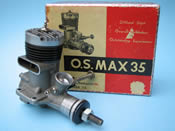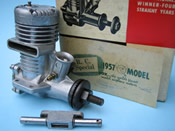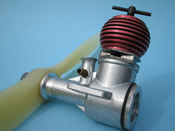The Russkies winning the space race spawned a craze for naming things which ended in "nik", so we had beatniks etc., plus the various model magazines featured wacky, novelty flying machines from designers like Pete Holland and the equally wacky Ray Malmstrom, who was always seen wearing a suit and bow tie on the flying field. It's funny now, but when you browse through old photo's taken on flying fields back in the late 40's and 50's, a lot of the modellers wore their Sunday best suits. Maybe the idea was that next Sunday in Church ( during a boring sermon ) one could pluck a hanky reeking of Diesel fuel out of your pocket and be transported back to the field by smell. That, or maybe just to annoy the stuff-shirt family seated in the pew behind.
On the musical side of things, 1957 will be remembered for Slim Dusty winning the first Australian Gold Record for his song about a bush calamity, "The Pub With No Beer", while Pat Boon has us all humming his smash hit, "Love Letters In The Sand".
The inspiration for Slim Dusty's catchy tune could well have come from the residents of Wyndham in N.W. Aust. after they charted a Bristol Freighter to fly in supplies of beer, when the barrels ran dry on the eve of the annual race meeting. "For old timers, it brought back painful memories of when the local publican died some years ago and was buried with due respect, only to be dug up again when the thirsty mourners discovered that the key of the bar was still in his pocket". Only in Australia!
At that time we had a valve radio and record player combined ( the Radiogram ) and when we weren't forced to listen to Mum and Dad's Jimmy Shand & his Band playing Scottish music, we slipped our Buddy Holly EP ( extended play ) record on, and rocked along to songs like "That'll be the Day". Having an interest in aeroplanes meant that every week-day after school, I would also listen to the radio serial "Hop Harrigan" along with a more marine slanted serial "Captain Silver and the Seahound". Radio ( or wireless as we called it ) of course, was the main form of entertainment, and just about everybody tuned in to "Mrs Ôobs" and "Blue Hills" ( by Gwen Meredith, episode number 4,697 ! ) around lunch time, while in the afternoon we had "Yes What" ( Goood Morning Sir- Good Morning Boys ) and on Sunday nights ( if you were brave ) you listened to the spooky "Inner Sanctum" ( the creaking door ).
On May 29th 1957, two reasonably famous aeromodellers ( Bob Palmer and Howard Bonner ) left L.A. International Airport for a 37 day demonstration tour of England and South Africa. Covering around 30,000 miles, the pair expertly flew their respective models, both Bonner's R/C and Palmer's C/L planes being powered by the then new VECO Series 100 "35" glow engines. Bob and Howard are pictured on the cover of the Oct. 57 issue of M.A.N. with Bob holding a tricycle undercarriage version of his Mk. 1 "Thunderbird" while in England he also flew a radial cowled model with conventional tail dragger configuration. The first big stunter I ever saw was a Mk.1 T-bird, and the chap that owned it transported it around on the roof of his FE Holden ( the latest model then ) in a purpose made roof rack clamping the wings.
Back in the U.S.A, not long after Top Flite announced they were kitting the ( what became known later as ) Green Box "Nobler", the 1957 U.S. Nationals were held at the Willow Grove Naval Air Station in Pennsylvania. A George Aldrich from Tyler, Texas won the Open Stunt event, also the High Point Stunt in a fly-off with Art Pawloski ( Snr. Stunt winner ). Art flew his Detroiter style "Atom" design while George flew a "Nobler" which incidentally, is pronounced the same way as the word in this sentence; "Nobler than thou". The kit sold for $7.95 in the States.
Fans of Elvis Presley in the U.S. appealed to their President, Dwight D. Eisenhower to stop the induction into the Army of their favourite rock & roller, but Ike stayed right out of it and kept merrily flying around in his personal transport, an Aero Commander 680 Super. Meanwhile, in Fort Smith Arkansas, Duke Fox had produced his first 4-bolt backplate 35, and also purchased for himself a Cessna 172. Some Elvis hits of that year included "Teddy Bear", "All Shook Up" and "Jailhouse Rock". In Australia, a stunt flyer by the name of Tony Farnan was making a name for himself flying "Socks", followed by a great looking design called the "Ramrod" ( was kitted by Montgomery Models ) and alongside this on shop shelves you could buy a Keil Kraft "Stunt Queen" kit and a FROG 500 or AM 35 to power it with. For reasons I can't recall now, the aforementioned "Mills Mite" never flew, and my first really successful C/L trainer was the Montgomery Models "Tiger", the plans of which show ( unusually ) a German Taifun Hobby 1cc engine fitted to this great little model. The 1957 Aussie Nats. were held in Tasmania at Campbell Town, and 1st place in the stunt event went to Bob Hyde flying an OS 35 powered Thunderbird ; 2nd place was taken by Tony Farnan with an OS 29 Ramrod, and 3rd place another Ramrod, Ian Wright. Across the pond in jolly old England, 1957 marked the 10th Anniversary of control line flying in Great Britain and by co-incidence, the E.D "Competition Special" also celebrated its 10th Birthday. Even in the E.D. adverts of the time, it was proclaimed a veteran, and it had held the 1950 British Speed Record for C/L flight at a sizzling 89.95 miles per hour ! On top of all these 10th Anniversarys, the famous model firm of Henry J. Nicholls who used to place those tantalising adverts for kits & engines, also celebrated 10 years in the trade As a lad in 1957, I found it very difficult to obtain the English model aeroplane magazines of the period in our rural area, and I usually had to wait until our annual holidays in Sydney before getting hold of a "Model Aircraft" or "Aeromodeller". We would drive the 250 miles to ( usually ) Bondi Beach, and the first night there would be spent in excited anticipation of the morrow. I could barely wait to journey into the city on a tram ( yes, Sydney had trams then, and I used to look in wonder at the Conductor, especially on wet days, as he swung in & out of the compartments in the old "toast rack"trams ) and head off to firstly, Levenson's in Pitt St. and Hobbyco and Walther & Stevenson's, both in George St. Not being old enough to walk around the city by myself, I had to squeeze my trips to Nirvana in between watching boring matinee movies like "South Pacific", or even worse, a trip to the Tivoli Theatre to hear interminable piano playing by Winifred Atwell, all of which Mum and Dad seemed to enjoy. If I had been lucky enough to score an issue of "Aeromodeller" earlier in the day, the interval at the movies was put to good use by closely studying the ads. for FROG, E.D., Mercury kits, Keil Kraft etc. and deciding what item would be purchased, if finances allowed. If I bought a kit, this would be taken back to our place of lodgement, and over the ensuing week or so, that kit would have the contents emptied onto the bed and repacked many times over. Any modelling magazines purchased on annual holidays would be transported home in triumph, and many a cold winter's evening spent in front of an open wood fire sifting through the latest information contained therein. Thus, a magazine bought in January on holidays had to last all year. The actual road journey to the Big Smoke also included some things of interest for a young lad - not far from Sydney, the road passes right by the Richmond Air Force Base and in those days, one could see rows of Neptune and Lincoln bombers lined up, plus any visiting RAF or USAF aircraft. One thing that has stuck in my mind all these years though, is there used to be a roadside advertisement for Penfolds Wines, somewhere near Penrith, I think. It took the form of a small monoplane ( purpose built but quite real looking ) which was propped up with its tail in the air, the nose on the ground and across the wings was painted this message - "Don't Crash, Drink Penfolds". Wonder what the do-gooders of today would think of that slightly less than politically correct advertising slogan ? We didn't have a car radio back then, but we still kept up with the latest releases like that all time classic from Sam Cooke, "You Send Me" or "Diana" by Paul Anka ( he wrote the song in honour of his baby sitter!).
In Model Airplane News August 1957, Peter Chinn in his Foreign Notes declared - "After a lapse of several years, during which time no Australian model magazine has been published, 1957 opened with the simultaneous appearance of two brand new mags. Unfortunately, neither publisher apparently knew of the impending appearance of a rival which means that both will need the utmost co-operation from Australian modellers to keep the ball rolling. One of these papers, the 24 page Australasian Aeromodelling, published monthly in Victoria and intended to cover both Australia and New Zealand is edited by Bob Rose, former secretary of the Model Aircraft Association of Australia, with the assistance of model flyers Derry Brown and John French. The other mag. Model News, published in New South Wales, is run by two well known Australian modellers, Adrian Bryant and Russ Hammond".
That first issue of Model News contained a plan and article for the "Carioca", an attractive stunt model designed by Mike Ware for the Sabre 29. The Sabre motors produced, of course, by Gordon Burford in South Australia, were commented on in the English model magazines as having hardened steel cylinders, especially to combat the very dusty Australian conditions. I well remember an Oliver Tiger Mk. 111 which was given to me years later by a friend - it had been taken to one of our dusty Aussie Nats and had ingested a large dose of fine grit, which reduced the Olly to only being able to run in short bursts at a time. It would start OK, but after about 20 seconds or so it would slow down and stop as compression was lost in the expanding cylinder.
1957 saw Gordon Burford release a Series 2 of his TAIPAN 2.5cc Diesel Mk. 1, the first to bear the TAIPAN name but having no markings whatsoever on the crankcase to inform the casual observer as much. The photograph below shows a new and un-run example of a TAIPAN 2.5 Mk. 1, Series 2 fitted with an original 1957 FROG nylon prop. The second photo is of a 1957 OS Max 11 "35" which came in a box proclaiming several alternative meanings for the letters "OS", ie. Offhand Start, Overall Splendour, Outstanding Superpower! Wonder why Mr. Ogawa marked the crankcases on the Max 1's and Max 111's as such, but not the Max 11's ? Hmmm.
The third photo is of a genuine ( note documentation to prove it!) 1957 Fox 35 R/C engine, which was basically obsolete even before it hit the shop shelves, due to rapid advances made in R/C venturi type throttles. The object beside the Fox is the crude "throttle" which bolted to the exhaust port. Note the special cylinder head fitted, which combined with the altered timing might just make a good C/L stunt engine!
The little AM 35 needs no introduction and reeks of 50's modelling nostalgia.

OS Max II 35, featured Overall Splendour!

Fox 35 R/C

Taipan 2.5 Diesel
About this same time in England, the World's first observed ( official?) flight by a true electrically powered model aeroplane was accomplished by Col. Taplin's 90 inch wingspan "Radio Queen". This feat was achieved using 20 Venner 1.5 amp/hr. silver zinc battery cells weighing 22 ounces, with a further 5 extra cells for boosting take off power to 30 volts. The motor used was a war surplus 24 volt aircraft servo motor drawing 8 amps, and flight times ( under power ) of 10 minutes were possible. The BIG fly in the ointment however, was the cost of the non-rechargeable batteries, something like US$84 at the time. Put into perspective, that same amount of money at the time would have bought you 7 new Holland Hornet's, or 3 new Dooling 29's AND a Veco 19 as well ! No wonder the electric crowd had to wait a few more decades to get cheap and reliable electric power and finally banish the smell of castor.
Still in England, the 1957 British Nationals were run ( as usual ) in miserable weather conditions. The premium stunt event, The Gold Trophy, was won ( for the third consecutive year ) by Pete Russell who flew his Focke Wulf 190 inspired "334G" in resplendent silver & green colour scheme and powered by an ED 2.46cc Racer. The 5th place getter was a T.G. (Gig) Eifflaender who used an engine of his own design and manufacture, the 2.49cc Eifflaender Special. This engine was listed as costing 6 Pounds 10 Shillings ( twice the price of an E.D. Comp. Special ) and was tested in the Christmas 1957 issue of Aeromodeller. A replica is currently available.
Some of the nicer models to appear in 1957 in England were the Mercury Marvin, designed by Dave Platt and kitted by Henry J. Nicholls Ltd. The same designer was responsible for the Marvin's bigger brother, the "Skiffler" which appeared in the June issue of Aeromodeller that year, and let's not forget that classic little design for small engines by the great Ron Moulton, the "Rascal" which appeared in the May issue.
Across the Channel, the 8th Criterium of Europe C/L event was held at Etterbeek, Brussels on June 15/16, with Henry Stouffs winning the stunt contest flying a Fox 35 powered Mk. 1 Thunderbird. The best team effort went to the Italians who flew Fox powered, reduced scale Bob Palmer "Smoothie" type designs. It's a very debatable point I know, but it could be argued that by 1957, control line flying had reached its zenith - pretty much everything that mattered had been tried & tested and not a lot came after. Apart from Bob Palmer winning the 1959 U.S. Nats. with his Mk. 2 "Thunderbird", there wasn't a great deal more to learn - it had all been done before. What followed was just detail. So in the final analysis, we have to conclude that, given the age of most C/L flyers today ( and the sad fact that no new blood is coming in to sustain our hobby ), our beloved pastime is fast approaching the point of extinction - within 20 to 25 years, control line flying will be just a memory. The things mentioned in this article are Golden Times - we won't see them again.
While the Enya factory was releasing their first ever Diesel design, the 15D Mk. 1 The Diamonds were singing Little Darlin' on the radio and the first Nuclear Civil Defence Manual was recommending that anyone caught near an exploding atomic device should wear gloves & hats, and use lots of soap and water. Thus ended 1957, although the final word must go to Her Majesty the Queen, who for the first time in history, appeared on television to deliver her annual Christmas message. PS On second thoughts, the final word must go to this anonymously written article which appeared in the Dec. 1957 issue of "Model Aircraft" and caused an absolute furore, resulting in copies being seized from newsagents and booksellers shelves (click here to see the article). Even though I have no idea what it's all about, it caused the only recall in the history of model aeroplane magazines, and that fact alone makes 1957 rather unique.
BOB ALLAN 2006.